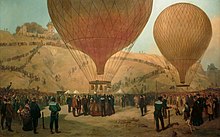Tea bag rocket
A tea bag rocket is a chemical-physical gimmick that can be carried out with thin-walled, cylindrically rolled paper. If you light the paper cylinder from above, it burns from top to bottom. When the last connected ash remains are light enough, they quickly fly upwards due to the hot air convection.
In the last third of the 19th century it was sold as a joke item under the name Gambetta balloon . It was named after the French statesman Léon Gambetta , who fled by hot air balloon from Paris, besieged by German troops, in 1870 with great media interest .
Structure and principle
A cylinder made of thin-walled paper, open at the bottom and top - tissue paper , cigarette paper or an empty, unfolded tea bag - is placed on a fireproof surface, e.g. B. on a plate, placed and evenly lit at the top. The paper burns downwards and the remaining ash structure quickly rises into the air.
The principle is based on the fact that the air around the cylinder is heated by its combustion (i.e. chemical oxidation of the paper) and that the convection of the heated air column physically pulls the light ash residues upwards.
In the commercial joke article version from 1871, the paper was previously dyed in a dilute oxalic acid solution (acting as a pickling agent with slight fire retardation) with the iron-containing dye Prussian blue (empirical formula: Fe 4 [Fe (CN) 6 ] 3 ), then dried and folded into a paper cylinder. During the combustion, finely distributed, coherent iron oxides remain, which give the burnt ash cylinder stability, and the entire network-like structure rises.
Naming
After the French statesman Léon Gambetta had spectacularly left besieged Paris with a balloon on October 7, 1870 , the gimmick was advertised and sold as a joke item under the ironic name of "Gambetta-Ballon" from 1871 onwards. Today's names are "tea bag rocket" or "flying tea bag".
use
Due to the easily available materials and the simplicity of the experimental set-up, the tea bag rocket is often used as a demonstration experiment for children and adolescents.
Web links
Individual evidence
- ↑ Renate Zerhusen: Beginners English - My Book About Me: Teaching ideas and materials for students with intellectual disabilities (5th to 9th grade) . Persen Verlag, Buxtehude 2012, ISBN 978-3-403-23143-1 , p. 16.
- ↑ Martin Apolin: Physics for real men . Ecowin, Wals 2015, ISBN 978-3-7110-5129-5 , p. 180.
- ↑ About the cause of the rise of the so-called Gambetta balloons. In: Polytechnisches Journal . 200, 1871, Miszelle 11, pp. 158-159.
- ↑ Kladderadatsch . A. Hofmann & Comp., 1871, p. 2.
- ↑ Technical youth leisure and education company (tjfbg) gGmbH : Flying tea bag . Retrieved November 29, 2017.
- ↑ Adventure Learning eV: Adventure Learning: Gravity and Flying: Scientific experience rooms for children in inclusive groups (3rd to 6th grade) . AOL-Verlag, Hamburg 2016, ISBN 978-3-403-40384-5 , p. 30.
- ↑ Urs Hangartner, Felix Keller and Dorothea Oechslin: Knowledge through images: non-fiction comics as a media of education and information . transcript Verlag, Bielefeld 2014, ISBN 978-3-8394-1983-0 , p. 284.
